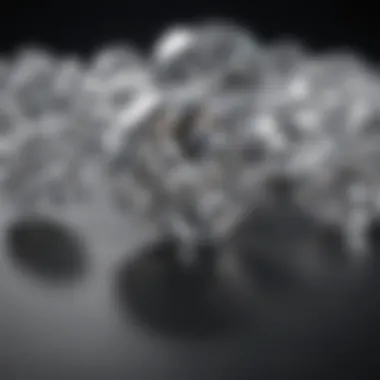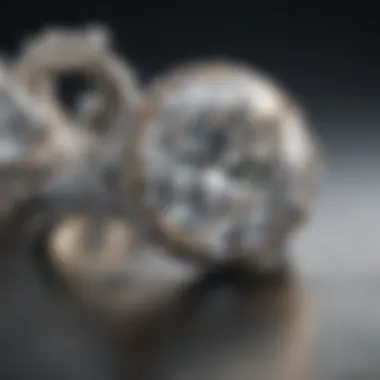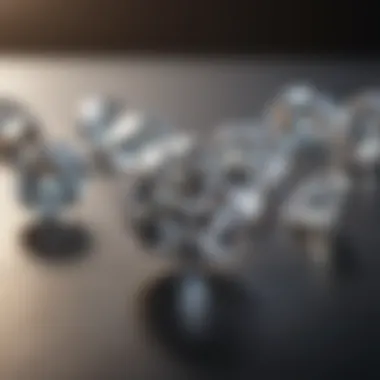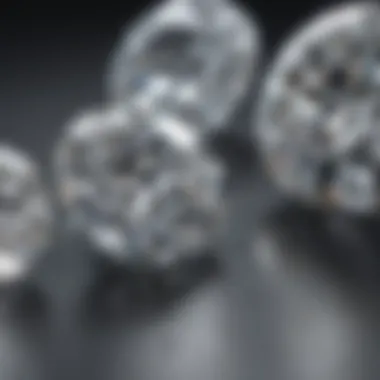Diamonds vs Moissanite: Key Differences Explained


Intro
In the realm of gemstones, diamonds and moissanite often find themselves locked in a captivating duel of brilliance. At first glance, both stones might dazzle the eye, yet their stories, compositions, and underlying values paint a more intricate picture. This exploration aims to dissect these differences, enabling enthusiasts and potential buyers to appreciate each stone’s unique charm.
Gemstone Overview
Definition and Origins
Diamonds, the quintessential symbol of luxury, are carbon-based gemstones that form deep within the Earth’s mantle under immense pressure and heat over the course of millions of years. Their rarity can drive prices through the roof; the term ‘blood diamond’ often comes with a heavy history tied to conflict and ethical concerns.
In contrast, moissanite is a relatively modern marvel. Originally discovered in 1893 in a meteor crater, this silicon carbide gem mimics the sparkle of diamonds while being man-made today in controlled environments. This origin story adds an interesting twist to the narrative of heavenly and earthly materials.
Historical Significance
Historically, diamonds have represented enduring love and commitment, often serving as the cornerstone of engagement rings. They occupy a prestigious space in both cultural myths and wealth accumulation. From the Crown Jewels of England to the finest jewelry pieces around the globe, diamonds have long been sought after for their beauty and perceived value.
Moissanite, however, is less entrenched in history. As it began to gain popularity in the late 20th century, it emerged as a more affordable alternative to diamonds. It quickly captured interest not only for its brilliant sparkle but also for its ethical and sustainable appeal, drawing in those wary of traditional gemstone mining practices.
Gemstone Properties
Hardness and Durability
When it comes to durability, diamonds take the cake with a perfect score of 10 on the Mohs scale of hardness. This unyielding quality makes them suitable for everyday wear, especially in rings that see the light of day continually. In practical terms, you’re less likely to face daily wear and tear with diamonds, contributing to their fondness in the jewelry sector.
Moissanite, while not as hard as diamonds—scoring about 9.25—still boasts impressive durability. It can withstand regular use exceedingly well and won’t easily chip or break, making it a practical choice for those seeking something visually stunning without the diamond price tag.
Color and Clarity
Both gemstones offer a spectrum of colors, but their clarity levels set them apart. Diamonds can appear in various hues, dictated by impurities and chemical compositions—ranging from colorless to shades of yellow, brown, and even rare colors like blue or pink. The clarity of diamonds is meticulously graded, with the most coveted grades attracting soaring prices.
Moissanite shines brightly with a near-colorless appearance. It can sometimes exhibit a fiery “dispersive” quality that many admire. Its clarity is generally high, and fine specimens can present as flawless. Many buyers appreciate moissanite for its ethical sourcing and impressive visual performance, which is hard to rival.
"Understanding the nuanced distinctions between diamonds and moissanite can empower consumers to make informed choices, particularly in today’s market where sustainability holds significant clout."
Finale
In sum, the battle of diamonds versus moissanite highlights not just the measurable factors like hardness and color but also the cultural narratives and ethical considerations surrounding each stone. As prospective buyers explore the world of gemstones, distinguishing these factors will aid them in making choices that resonate with their values and aesthetics.
Prologue to Gemstones
Gemstones have long captivated the human imagination, serving not only as decorative ornaments but also as symbols of status, love, and cultural identity. In the realm of jewelry, diamonds and moissanite are two contenders that transform ordinary moments into extraordinary memories. Understanding gemstones, particularly these two, provides valuable insights into their significance in various contexts—be it cultural, emotional, or economic.
Exploring gemstones involves digging into their histories, qualities, and roles in society. This knowledge equips enthusiasts and potential buyers with the ability to appreciate the subtleties that differentiate a diamond from a moissanite, not to mention how each stone aligns with personal values and aesthetics.
The Importance of Gemstones in Culture
Gemstones have been cherished across cultures for centuries. They appear in folklore, literature, and religious texts, often depicted as precious offerings or tokens of affection. For some, they are imbued with mystical properties, believed to bring good luck or protection. From the deep blue of sapphires to the fiery red of rubies, each gem tells a story steeped in tradition and belief.
Jewelry crafted from these stones often serves as a rite of passage during significant life events—engagement rings crafted from diamonds symbolize unending love, while moissanite’s increasing popularity reflects modern values of sustainability and affordability.


Moreover, gemstones can signal wealth and achievement, woven into social customs that underscore their lasting importance in human interactions. This complex relationship illustrates how gemstones resonate with cultural narratives, transforming mere rocks into objects of reverence.
Overview of Popular Gemstones
Several gemstones have garnered favor over the years, each boasting unique characteristics that appeal to diverse tastes. Here’s a closer look at some popular options:
- Diamond: Often considered the strongest and most prestigious of gemstones, diamonds represent love and commitment. Their brilliance and rarity make them highly sought after.
- Ruby: Known for their vibrant red hue, rubies are often associated with passion and protection.
- Sapphire: While blue is the most coveted sapphire color, they also come in a variety of hues. Their durability and timeless beauty make them popular in engagement rings and other fine jewelry.
- Emerald: These green stones symbolize rebirth and love, uniquely captivating the beholder with their rich color and historical significance.
- Moissanite: Emerging as a popular alternative to diamonds, moissanite offers a captivating sparkle at a more accessible price point, appealing to budget-conscious buyers who still desire elegance.
Understanding Diamonds
Diamonds are often viewed as the pinnacle of gemstones, representing both luxury and a rich history. Understanding diamonds forms a crucial part of comprehending the broader narrative of gemstones, especially in comparison to moissanite. Each diamond tells a story that begins deep within the Earth’s mantle and culminates in their display in museums, jewelry stores, and private collections. Their symbolism and significance have woven them into the fabric of cultural traditions worldwide.
Formation and Origin
Diamonds originate under extreme heat and pressure, about 100 miles below the Earth's surface. Over millions of years, carbon atoms bond in a crystal structure, forming diamonds. Most are brought to the surface by volcanic eruptions. Knowing how diamonds form allows enthusiasts to appreciate the remarkable journey of these gemstones, as they transition from carbon-rich materials to sought-after treasures.
Physical and Optical Properties
Hardness and Durability
Diamonds are renowned for their hardness, rated a perfect 10 on the Mohs scale. This unique attribute makes them not only stunning choices for jewelry but also symbols of endurance and commitment. Their durability means they can withstand daily wear without scratching or damaging. However, despite their incredible strength, diamonds can chip or break if struck at the wrong angle—this is an important consideration for those purchasing diamond jewelry as a long-term investment. The idea that diamonds will last a lifetime contributes to their status as the ultimate gemstone choice for engagement rings.
Refractive Index
The brilliance of a diamond is often attributed to its high refractive index, which measures how much light is bent when entering the stone. This property creates the sparkle that captures the eye and draws admiration. With a refractive index around 2.42, diamonds exhibit exceptional fire, creating colorful flashes of light. Owning a diamond means embracing its captivating glow, which is why consumers often prioritize this attribute. Yet, it's important to acknowledge that diamond brilliance can vary based on cut quality—a poorly cut diamond may not exhibit the same level of brilliance as one expertly crafted.
Color and Clarity
Diamonds come in a range of colors, though the most highly prized are those that are completely colorless. The Gemological Institute of America (GIA) uses a scale ranging from D (colorless) to Z (light yellow) when grading diamond color. Clarity, on the other hand, deals with identifying any internal or external flaws, known as inclusions and blemishes. Higher clarity means less visible imperfections, leading to a more desirable stone. The combination of color and clarity influences a diamond’s value significantly. Understanding these characteristics can aid buyers in selecting the perfect stone that aligns with their aesthetic preferences and budgets.
Cultural Significance
Symbolism and Tradition
Diamonds have long been associated with love and fidelity, often viewed as a symbol of unbreakable commitment. From ancient civilizations to modern society, they have represented wealth, power, and status. The tradition of giving diamonds as engagement rings emerged in the 19th century, subsequently engraving their importance into the social fabric. Understanding this cultural significance can help individuals appreciate the deeper meaning behind diamond jewelry beyond just its material value.
Diamonds in Popular Culture
Diamonds have made their mark in various aspects of popular culture, from movies and music to literature. Phrases like “Diamonds are a girl’s best friend” and the glamorous portrayal of diamonds in media have cemented their status as symbols of luxury and desire. These cultural references elevate diamonds to almost mythological status, influencing consumer behavior and societal perceptions. Recognizing this cultural backdrop enriches one’s appreciation of diamonds, adding layers to their allure.
The Diamond Market
Market Dynamics
The diamond market operates under unique dynamics influenced by various factors. Supply, demand, and global economic conditions play critical roles in shaping market behaviors. The De Beers Group, historically a central player in the diamond industry, has significantly influenced market practices and pricing strategies through their control of the diamond supply. Understanding these dynamics is essential for buyers to navigate the complexities of purchasing diamonds, ensuring they know when to invest based on market trends.
Pricing Factors
Several factors determine a diamond’s price, including the 4Cs: carat, cut, color, and clarity. Each attribute can influence the cost dramatically, leading to significant price variations even among seemingly similar stones. Additionally, brand reputation, geographic location, and current market trends also play a part in how diamonds are priced. For consumers, being savvy about these pricing factors can assist in making informed decisions that align with personal values and financial preferences.
An Preface to Moissanite


Moissanite is becoming a familiar name among jewelry lovers and gemstone enthusiasts alike. Its unique properties and affordability have propelled it into the limelight as a worthy alternative to diamonds. It presents itself not just as a gemstone but as a symbol of evolving consumer preferences toward ethical and sustainable choices in jewelry. As more individuals seek alternatives that do not compromise on beauty or quality, moissanite enters the discussion with its own set of advantages that warrant careful consideration.
History and Discovery
The origins of moissanite trace back to 1893, when a French chemist named Henri Moissan discovered tiny crystals in a meteorite crater in Arizona. Originally mistaken for diamond, the remarkable brilliance and fire of these crystals caught the attention of the scientific community. Eventually, moissanite was synthesized for commercial use in the early 1990s. While its natural form is rare, synthetic moissanite has gained immense popularity due to its stunning visual appearance and relative affordability compared to natural diamonds.
Chemical Structure and Properties
Comparison of Hardness
One of the standout attributes of moissanite is its hardness, measured at 9.25 on the Mohs scale. This places it just below diamonds, which measure a perfect 10. The exceptional hardness of moissanite means it is highly resistant to scratches and suitable for daily wear. For consumers considering longevity and durability in their gemstones, this makes moissanite a smart choice.
Refractive Index and Fire
Moissanite boasts a refractive index ranging from 2.65 to 2.69, one of the highest among gemstones. This attribute is critical because it significantly impacts how light interacts with the stone, resulting in a fiery sparkle that can outshine many diamonds. The unique optical properties of moissanite deliver a dazzling display, appealing to those who appreciate brilliance in their jewelry.
Color Range
When it comes to color, moissanite has a discernible advantage, offering a range from colorless to varying shades of near-colorless. This variety allows consumers to select a stone that aligns with personal taste and style. However, it’s worth noting that the most colorless versions can be more sought after, resembling the coveted D-color diamonds. Thus, the color spectrum of moissanite extends options for buyers, making it a versatile gemstone.
Cultural Acceptance
Emerging Trends
In recent years, there’s been a noticeable shift toward embracing moissanite as a fashionable and ethical choice. More couples, especially millennials and Gen Z, view moissanite as a symbol of commitment that aligns with modern values. As environmental concerns rise, opting for a lab-created gemstone resonates more with a generation prioritizing sustainability in all aspects of life.
Moissanite in Jewelry
The rise of moissanite in jewelry is defying traditional norms. Designers are integrating moissanite into various pieces, from engagement rings to earrings, underscoring its versatility and appeal. Its aesthetic qualities and affordability further cement its position in the market, attracting those who appreciate beauty without excessive financial burden.
Market Position of Moissanite
Consumer Preferences
Moissanite's surge in popularity reflects changing consumer habits. Many are now inclined to choose moissanite over diamonds for its ethical sourcing and lower price point, which can be significantly more attractive for budget-conscious buyers. As conversations around sustainability continue, more consumers are likely to embrace moissanite as a preferred gemstone.
Pricing Trends
When discussing pricing trends, moissanite consistently stands out for its affordability compared to diamonds. Generally, a moissanite gem can retail for about 10-20% of the price of a comparable diamond. This financial advantage, paired with its striking appearance, makes moissanite an increasingly favorable choice for those looking to balance cost with aesthetic appeal.
Comparative Analysis of Diamonds and Moissanite
In the grand tapestry of gemstones, diamonds and moissanite stand as two intriguing options that often catch the eye of buyers and enthusiasts alike. Their comparison unfolds layers of insights that reveal their distinct nature, from visual allure to durability, and even to their environmental responsibility. This section sheds light on these aspects, aiming to equip readers with the understanding they need to make informed decisions in the realm of fine jewelry.
Visual Characteristics
When discussing gemstones, one cannot overlook the visual charm that each brings to the table. Diamonds, with their renowned brilliance, captivates with a sparkle that appears to dance with light in a way that many other stones simply cannot replicate. Their well-earned reputation stems from their superior refractive index, which is why they are often described as the epitome of radiance and elegance.
Moissanite, on the other hand, isn't far behind in creating visual impact. This gemstone boasts a refractive index even higher than that of diamonds, which results in a flashiness that some might find alluring, yet might occasionally tip into being overwhelming. While diamonds radiate a classic sparkle, moissanite brings a fiery brilliance that many viewers find genuinely enchanting.


"While diamonds convey timeless elegance, moissanite captures vibrancy with every turn."
Durability and Maintenance
When it comes to durability, both diamonds and moissanite emerge as formidable contenders. Diamonds hold a perfect score of 10 on the Mohs scale of hardness, making them impressively resistant to scratches. This quality ensures that they retain their polished look even after years of wear. Moissanite comes in a close second, boasting a hardness of 9.25. Although it’s less likely to scratch, it's still a reputable choice for everyday wear and can endure life’s hustle and bustle without a hitch.
In terms of maintenance, both types of gemstones are relatively low-maintenance. Regular clean-ups with mild soap and a gentle brush can help both types shine bright. However, moissanite does have a advantage when it comes to resisting more common types of staining. It generally has a more forgiving nature regarding dirt and grime, which means it can stay looking pristine longer with less effort.
Environmental Impact and Ethical Concerns
The environmental implications of gemstone production weigh heavily on the minds of conscientious consumers. Diamonds, though beautiful, often have a complicated narrative. Traditional diamond mining can bring about ecological repercussions, including habitat destruction and water pollution. Moreover, the issue of conflict diamonds—stones mined in war zones to fund armed conflict—has led to increased consumer awareness about ethically sourced gems.
Moissanite, in stark contrast, practically sidesteps these concerns as it can be lab-created. This feature allows it to present a more sustainable option for gem lovers who prioritize ethical standards. The production of moissanite in controlled facilities means less environmental disturbance and a transparency that many consumers appreciate. This growing trend prompts a dialogue about consumer choices, urging us to consider our impact on the planet when selecting gemstones for adornment.
Consumer Considerations
When it comes to purchasing a gemstone, consumers often find themselves at a crossroads. The choice between diamonds and moissanite is not just a matter of personal preference; it involves deeper considerations such as emotional connection, financial impact, and societal perceptions. Undoubtedly, these factors influence a buyer's decision. So, let's unpack the crucial aspects surrounding consumer choices in this contemporary context.
Selecting Between Diamonds and Moissanite
For many, selecting a gemstone involves more than just the stone’s brilliance. A diamond has longstanding allure; its cultural roots run deep, often tied to notions of commitment and celebration. On the other hand, moissanite, though younger in jewelry history, has gained momentum among consumers seeking sustainable and budget-friendly options. Many buyers now weigh their need for tradition against a desire for innovation.
- Traditional Choice: Diamonds have been symbols of love and promise for decades. They usually come with a hefty price tag due to their rarity and demand.
- Modern Option: Moissanite shines brightly, offering superior fire and spark despite being manufactured. It challenges the market's narrative, presenting a fresher alternative that’s not just economical but also ethically intriguing.
When making a decision, consumers must examine their values, whether they lean towards an established tradition or are open to embracing new standards of beauty that are less conventional. The emotional investment in a diamond often brings about a sense of nostalgia, while moissanite offers a place in the modern narrative of gemstone appreciation.
Evaluating Value for Money
In an age where financial savvy is golden, evaluating value for money takes center stage in gemstone purchases. Consumers are not merely looking for beauty; they seek substance and longevity within their investment.
Diamonds can carry an immense financial commitment, sometimes resulting in significant debt for those wishing to purchase a piece. In contrast, moissanite brings a value proposition that is hard to ignore:
- Price and Accessibility: Moissanite typically costs 10-15% of a diamond with similar size and quality, making luxury more accessible.
- Durability and Performance: Both stones are hard minerals, but moissanite has distinct durability advantages in certain settings.
- Resale Value: Diamonds often fetch higher resale prices due to their status, while moissanite is still gaining recognition in the secondhand market.
The consideration of value goes beyond mere numbers. It's about what resonates personally and socially, whether you’re drawn to diamonds' storied legacy or moissanite’s modernity. By weighing these factors carefully, consumers can make informed choices that align with their lifestyle and beliefs.
Thus, the intricate choice between diamonds and moissanite necessitates a blend of personal preference and financial insight. As consumers navigate through these considerations, they contribute not just to their journey but also to the evolving narrative around gemstones in today’s world.
The End
In the grand scheme of gemstones, the comparison between diamonds and moissanite emerges not merely as a discussion of aesthetics but also as an exploration of values, ethics, and personal choices. As consumers navigate their way through the glittering landscape of jewelry options, understanding the nuances between these two stones becomes paramount.
Firstly, it's essential to recognize that both diamonds and moissanite carry their own unique narratives, steeped in history and cultural significance. Diamonds, historically seen as the epitome of luxury and status, have long been intertwined with rituals and traditions. On the other hand, moissanite has risen as a symbol of innovation and progress, appealing to a more modern sensibility that values environmental sustainability and ethical considerations.
Additionally, the market dynamics surrounding both stones offer insight into broader consumer trends. Prices and availability are influenced by a myriad of factors—market demand, sourcing methods, and even the rise of synthetic alternatives, which requires consumers to be more informed than ever.
"The choices we make reflect our values, aspirations, and even our identities."
When pondering whether to opt for a diamond or moissanite, potential buyers must assess their priorities, whether they're leaning towards the time-honored allure of a diamond or the contemporary charm of moissanite. This decision extends beyond mere aesthetics; it encompasses considerations of ethics, durability, and cost-effectiveness. A ring might sparkle, but the story behind it adds layers of meaning that make it truly special.
Final Thoughts on Gemstone Choices
As the curtain falls on this comparative study, it's worth reiterating that gemstone choices echo one's values and lifestyle. For the traditionalist, a diamond might symbolize a deep-rooted commitment to rituals steeped in age-old significance. In contrast, those who value modernity and sustainability may find moissanite aligns more closely with their ethos.
In a world where consumers increasingly seek products that mirror their philosophies, understanding the identities of both diamonds and moissanites moves beyond beauty. It invites introspection about what these gems represent in our lives. Whether for engagement rings, anniversary gifts, or simply personal adornment, savvy buyers will take the time to weigh their options, assess the meanings, and reflect on their long-term significance.
Ultimately, whether one chooses the classic brilliance of a diamond or the contemporary facet of moissanite, both gemstones offer paths to express love, significance, and individual style. The choice is as personal as the stories we weave around them.



